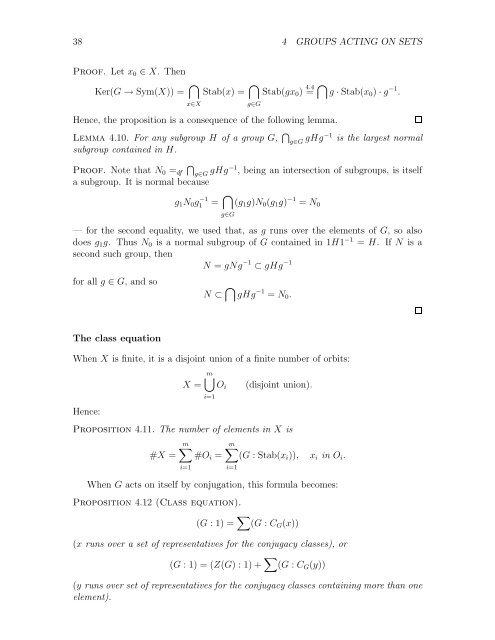Milne - Group Theory.. - Free
Milne - Group Theory.. - Free
Milne - Group Theory.. - Free
Create successful ePaper yourself
Turn your PDF publications into a flip-book with our unique Google optimized e-Paper software.
38 4 GROUPS ACTING ON SETS<br />
Proof. Let x 0 ∈ X. Then<br />
Ker(G → Sym(X)) = ⋂<br />
Stab(gx 0 ) 4.4<br />
= ⋂ g · Stab(x 0 ) · g −1 .<br />
Stab(x) = ⋂<br />
x∈X g∈G<br />
Hence, the proposition is a consequence of the following lemma.<br />
Lemma 4.10. For any subgroup H of a group G, ⋂ g∈G gHg−1 is the largest normal<br />
subgroup contained in H.<br />
Proof. Note that N 0 = df<br />
⋂g∈G gHg−1 , being an intersection of subgroups, is itself<br />
a subgroup. It is normal because<br />
g 1 N 0 g −1<br />
1 = ⋂ g∈G(g 1 g)N 0 (g 1 g) −1 = N 0<br />
— for the second equality, we used that, as g runs over the elements of G, soalso<br />
does g 1 g. Th us N 0 is a normal subgroup of G containedin1H1 −1 = H. If N is a<br />
second suchgroup, then<br />
N = gNg −1 ⊂ gHg −1<br />
for all g ∈ G, andso<br />
N ⊂ ⋂ gHg −1 = N 0 .<br />
The class equation<br />
When X is finite, it is a disjoint union of a finite number of orbits:<br />
X =<br />
m⋃<br />
i=1<br />
O i<br />
(disjoint union).<br />
Hence:<br />
Proposition 4.11. The number of elements in X is<br />
#X =<br />
m∑<br />
#O i =<br />
i=1<br />
m∑<br />
(G :Stab(x i )), x i in O i .<br />
i=1<br />
When G acts on itself by conjugation, this formula becomes:<br />
Proposition 4.12 (Class equation).<br />
(G :1)= ∑ (G : C G (x))<br />
(x runs over a set of representatives for the conjugacy classes), or<br />
(G :1)=(Z(G) :1)+ ∑ (G : C G (y))<br />
(y runs over set of representatives for the conjugacy classes containing more than one<br />
element).

















